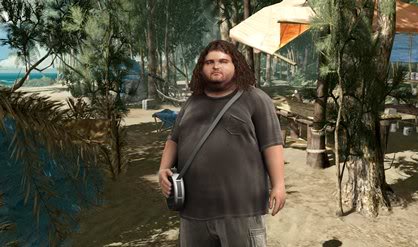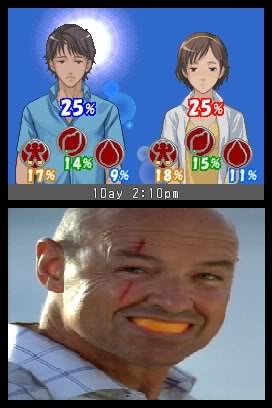
With the home release of the final season of LOST this week, fans and non-fans alike are no doubt pleased. Those who have kept up with the series over the years have completed their collection and have one last DVD set to delve into while everyone else finally gets to hear them shut up about smoke monsters and polar bears once and for all.
After the final curtain has fallen on the remaining castaways, what remains for the unsated? When the appeal of making knock-off Dharma Oreos and fish biscuits in your basement wears off, there’s always Lost: Via Domus…right?
Let’s be honest: Lost: Via Domus doesn’t have much going for it. It’s not part of the official show canon. It’s rather short. Some of the sound-alike actors are truly awful – Locke in particular falls somewhere between a generic old geezer and a bored prospector, while Sawyer’s voice sounds, to credit a user review on 1UP, “two jugs short of a Country Bear Jamboree.” And Hurley? Yikes. His character model might as well be a palette-swapped Pizza the Hutt.
So what do you get when all is said and done? For about five hours of your time, you’ll net a shamefully easy 1,000 achievement points and a couple of yuks as you exchange pleasantries with some of the digital recreations of everyone's favorite castaways. Exploring some of the recreations of Lost territory such as the beach camp, interior of The Hatch and some of the Dharma stations is sure to elicit some interest.
However, Via Domus is just full of bizarre gameplay choices. The game has a relatively sophisticated interface for gunplay, but only contains about three bullets and two potential targets to shoot them at in the entire course of the game. Reaching some of the optional, and frankly most interesting, locations is impossible without a FAQ detailing which arbitrary objects to trigger in which arbitrary order. I could go on, but you knew Via Domus wasn’t a good game before you even clicked the link to open this feature. Unfortunately, this seems like a project that was doomed from the start. I’m not exactly sure how one would go about making a decent Lost game that wasn’t either a browser-based Alternate Reality Game (ARG) or some kind of Myst clone.

My apologies to Jorge Garcia.
I find the difficulty of making Lost into a game particularly odd. Though it may sound strange at first, what drew me to the show in the first place was the similarity in structure to a video game. As the stories told in popular media grow more complex and seek to connect with viewers on a deeper level, I think we will begin to see inevitable comparisons to elements gamers have been familiar with for years. I'll be referencing mostly old-school Seasons One-through-Three Lost here, but someone with only a passing familiarity with the series should be able to follow along and avoid most spoilers.
Heavy emphasis and story progression through inventory and limited resources.
As with any story with an island castaway theme, there will obviously be a limited or controlled number of resources. Lost is no different, with much of the first season characters being mostly preoccupied with finding enough food, water and shelters to go around. When the story calls for it, a “key” item such as a gun or radio will be discovered. Much like a video game, the specific acquisition of new items has the potential to greatly effect the gameplay or narrative arc. Did you know it was a crew member’s job to keep track of who had which items at what times for the entirety of the first few seasons? Each character could be considered to have their own inventory of items that directly influences how they interact with the story. Although video games are becoming increasingly open-world, the player is ultimately limited to the specific items programmed into the game to achieve their goals and move the story forward. Seeing a pattern?
In a setting like Lost (at least before the off-Island scenes became common), the characters are similarly limited to a set number of resources to work with. As the viewer watches or “plays along” with the characters, they themselves are limited in the ways they can anticipate potential plot points and solutions to problems. “Why don’t they just use X to do Y?” is no longer a valid viewer-to-character interaction – each is only working with whatever items the writers have so far revealed. This kind of limitation invites the viewer to approach the situations and goals of the characters in a more thoughtful, less passive manner.
Discrete “levels” and environments. Goal-based gameplay unlocks new playable areas.
It’s a valid argument that the settings on Lost are nearly as important and memorable as the characters themselves. The movement from the wreckage-littered beach camp to the more secure caves punctuates the first big decision of the opening season, as does the eventual discovery of the various Dharma stations that dot the island map. The environments themselves are directly related to item acquisition and plot movement as well: The Hatch adds a huge arsenal of weapons and food to the previously meager possessions of the group, the Black Rock becomes a respawning dynamite stock point and the signifigance of mysterious key items (mysterious VHS recordings, broken statuettes) is teased on a weekly basis. Each character has the motive to explore each new environment for useful survival items and the curiosity of the viewer is fueled by the game-like clues and puzzles found in each.
One of the largest story arcs of the first season is the discovery of a sealed hatch buried in the ground. It’s one of the first hints of civilization on the island and really marks the transition of the show from a Survivor–like drama to something much more. Given the sealed hatch and a limited set of tools, the onus is on the characters to discover the way in and it’s anything but easy. However, doing so unlocks a new environment and items which in turn widens the field of play immensely. From the initial crash site and cramped caves, the sphere of “playable area” for the characters increases at a careful pace, devoting ample time to explore and chart each new place.
Multi-character narrative with shifting “control” of main players.
If there is a single reason for the early runaway success of Lost, it might be the ambitiously large cast of characters. The survivors of Flight 815 are a worldly sampling of different cultures, classes, languages and backgrounds. Although the story generally centers around certain key groups of people, there is no true main character. Each individual episode is centered around a different character who takes the weekly spotlight in both the on-island drama and off-island flashbacks. Generally the writers strike a balance between establishing and advancing a character personally within the framework of moving the plot ahead for the cast as a whole.
For the sake of the viewer, these can be considered “playable” – the story centers around them and is told through their point of view. What I like best about this kind of formula is that any character can become a main character. Someone who appears to start out as a simple NPC or apparent villian can become a player in a later episode. If the viewer fails to connect with a particular character one week, the chances are good that one they prefer is not far behind in the rotation. Each viewer naturally forms favorite characters and becomes anxious about learning more about them, once again forming a more active bond between the viewer, the characters, and the show as a whole.

Screenshot from the unfinished "Lost: Dharma Stories" for the Nintendo DS.
Establishment of a large player community with dynamic feedback from creators.
If Survivor is a multiplayer party game, Lost is a solo player story-driven adventure. However, the viewer isn’t the only one playing. At any given minute for the past six years, someone somewhere has been posting something about Lost on an online message board or discussing it over the phone or in person with other watchers. Part of the experience becomes immediately looking online after each episode airs to share opinions and theories with other watchers. The number of sites devoted to this simple function is staggering. Unlike some fan communities, it isn’t just a one way street. The writers keep a watchful eye on the resulting chatter after each episode and tweak the show accordingly in a way that likely has not been done to such a large degree before. It’s not perfect (after all, we still have Kate-centric episodes), but the internet has become a way for creators and writers to receive instant feedback from viewers and how to best push their buttons.
This has resulted in a back-and-forth exchange between creator and watcher that ultimately pays off for both week after week. Additionally, certain clues within the show are meant to be enjoyed outside the context of the show, mostly in the forms of books. In example, when the Flann O’Brien novel “The Third Policemen” was seen in an episode, viewers immediately began to find and read it to try to suss out hints about the show as a whole. In the three weeks following the airing of the episode it appeared in, “The Third Policeman” sold more copies than it had in the past six years. Other books such as Dicken’s “Our Mutual Friend,” Castaneda’s “A Separate Reality” and Kierkegaard’s “Fear and Trembling” have enjoyed similar rediscovery following their on-air appearences. The willingness to become involved in the mythology of the show in ways outside of directly watching it once again demonstrates the active connectedness that many viewers participate in while watching Lost.
Focus on games and rules.
More in line with current events on Lost, there have always been set rules in play for the characters. Whereas some series may make conceits or have ‘invisible boundaries’ that keep characters from discovering too much too soon or going to places they aren’t supposed to, Lost has always strived to push these limitations into the open and explore them. Some end up to be bluffs or men behind curtains pulling the strings, while others are still mysteries right down to the last episode. Whether it’s references to Mousetrap, the Egyptian game of Senet, cryptic clues hidden in real-world books or in the DVD liner notes, ARGs or hieroglyphics, there is always more of the game to play at any given point. While other shows operate within a given set of rules the viewer is familiar with, Lost fans relish the chance to discover and postulate about the rules themselves.
Although it may just be a current fad, other television shows have already tried to recreate the immersive style of Lost and build the same type of active fan communities that producers dream about. Whether or not you are a fan of LOST or play video games, the line between the passive viewer and participating player has begun to slightly blur – and it's an exciting time to be either one.
VentureBeat's mission is to be a digital town square for technical decision-makers to gain knowledge about transformative enterprise technology and transact. Learn More
